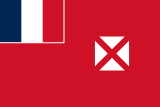Wallis and Futuna

About Wallis and Futuna
Wallis and Futuna, officially the Territory of the Wallis and Futuna Islands (French: Wallis-et-Futuna [walis.e.futuna] or Territoire des îles Wallis-et-Futuna, Fakauvea and Fakafutuna: 'Uvea mo Futuna) is a French island collectivity in the South Pacific, situated between Tuvalu to the northwest, Fiji to the southwest, Tonga to the southeast, Samoa to the east, and Tokelau to the northeast.
Its land area is 142.42 km2 (54.99 sq mi). It had a population of 11,558 at the 2018 census (down from 14,944 at the 2003 census). Matā'Utu is its capital and largest city. The territory is made up of three main volcanic tropical islands and a number of tiny islets. It is divided into two island groups that lie about 260 km (160 mi) apart: the Wallis Islands (also known as Uvea) in the northeast; and the Hoorn Islands (also known as the Futuna Islands) in the southwest, including Futuna Island proper and the mostly uninhabited Alofi Island.
Since 28 March 2003, Wallis and Futuna has been a French overseas collectivity (collectivité d'outre-mer, or COM). Between 1961 and 2003, it had the status of a French overseas territory (territoire d'outre-mer, or TOM). Its official name did not change when its status changed.
Mata-Utu
Mata Utu (French pronunciation: [mata.yty]; ʻUvean: Matāʻutu) is the capital of Wallis and Futuna, an overseas collectivity of France. It is located on the island of Uvéa (ʻUvea), in the district of Hahake, of which it is also the capital. It is one of two ports in Wallis and Futuna, the other being at Leava on Futuna. Hihifo Airport, the main airport accessing the island and city, is 5.6 kilometres (3.5 mi) to the northwest. Its population was 1,029 in 2018, up from 815 in 1998.The most prominent landmarks in the town are the Matâ'Utu Cathedral, the palace next to it and backdrop of the Mt. Lulu Fakahega where there is an old chapel.